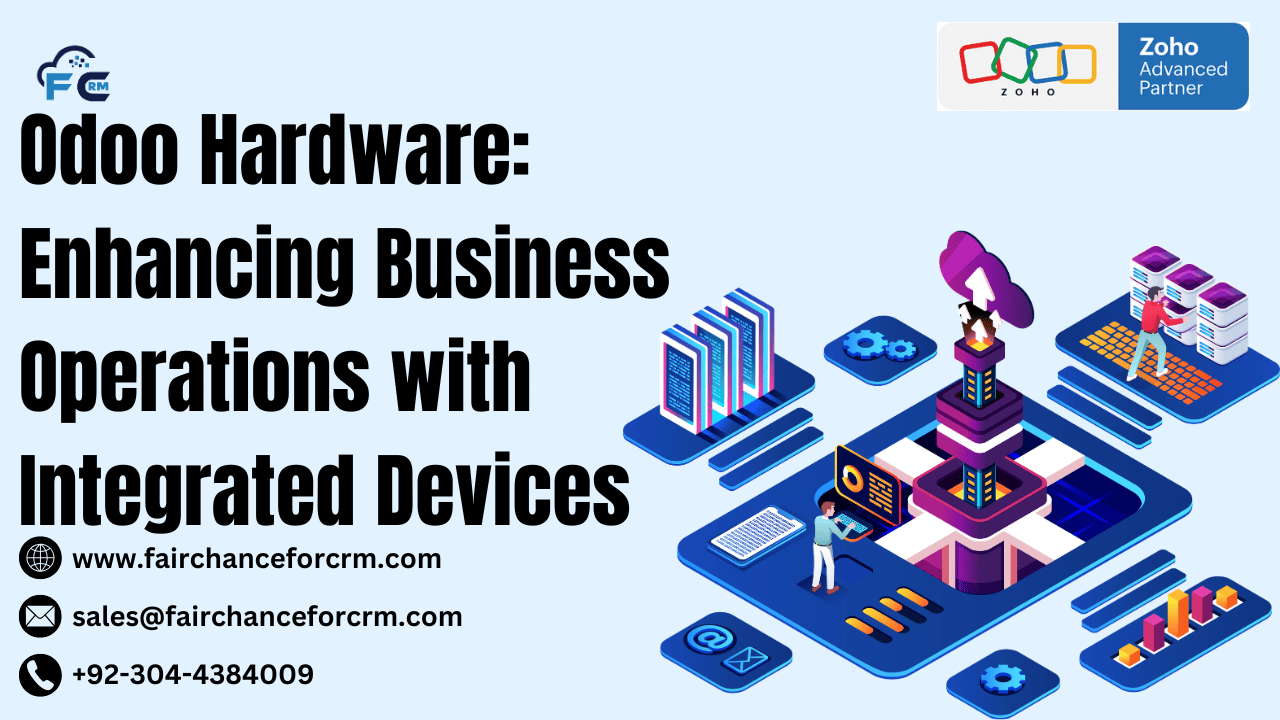Odoo is a comprehensive suite of business tools that assist firms in managing a variety of processes, including sales, finance, human resources, inventory, manufacturing, and more. Odoo Hardware is renowned for its modularity, versatility, and user-friendly design, making it an ideal solution for enterprises of all sizes. Odoo’s capability, however, goes beyond software; it also offers interaction with numerous hardware devices to enhance corporate processes and give a comprehensive solution.
In this post, we’ll look at how Odoo interfaces with hardware, what devices are typically used, and some coding examples for developing and configuring hardware integrations.
Also Read:
- Odoo Asset Management: A Comprehensive Guide
- Odoo Debug Extension: A Comprehensive Guide to Debugging Odoo Applications
- Odoo Studio: A Comprehensive Guide to Customizing Your Odoo Experience
- Maximizing Workforce Efficiency with Zoho Workerly
- Zoho Valuation: Understanding the Success of Software Giant
Odoo Hardware: Enhancing Business Operations
1. Hardware Integration with Odoo
Odoo’s core modules can be enhanced with hardware integration, enabling businesses to streamline their operations. Whether you are managing a retail store, warehouse, or factory, using the right Odoo Hardware devices alongside Odoo can make processes smoother and more efficient.
Here are some key hardware types that integrate with Odoo:
a) Barcode Scanners
Barcode scanners are often used in Odoo for inventory management, product tracking, and point-of-sale (POS) systems. By scanning barcodes, users can easily identify products, update stock levels, or check out customers during sales transactions.
Use Case:
- In a warehouse, an employee can scan items as they are received or dispatched to update stock levels automatically.
- In a retail store, cashiers can scan products to speed up checkout.
Coding Example: To integrate a barcode scanner with Odoo, you can use the product_barcode module or write custom logic to handle barcode data.
b) Receipt Printers
Receipt printers are commonly used in Odoo for generating invoices and receipts in retail, restaurants, and service-based businesses. These devices can connect to Odoo via USB, network, or Bluetooth and are integrated within the Odoo POS system.
Use Case:
- When a customer makes a purchase, the receipt printer generates a printout with the purchase details.
Coding Example: For Odoo POS, receipt printing can be integrated using the pos_printer module, or you can use JavaScript to interface with the printer from the web client.
c) Cash Drawers
Cash drawers are integrated into Odoo’s POS system to manage cash transactions. These devices open automatically when a cash transaction is processed.
Use Case:
- After a successful sale, the cash drawer opens automatically to facilitate the exchange of cash.
Coding Example: You can control cash drawer operations using the POS interface and trigger the opening of the drawer programmatically:
d) POS Terminals
POS terminals are the primary Odoo Hardware used in retail businesses for sales transactions. These terminals may include a combination of a touch screen, barcode scanner, receipt printer, and payment terminals. Odoo POS integrates seamlessly with these devices.
Use Case:
- The entire point-of-sale setup can handle transactions, print receipts, and update inventory all in one system.
e) Weighing Scales
In industries such as food, logistics, and retail, weighing scales are crucial hardware devices. Odoo can integrate with these devices to automatically record weights of products and update inventory or sales data accordingly.
Use Case:
- In a supermarket, a scale can weigh products and provide the weight data for pricing in the POS.
Coding Example: Integration with weighing scales typically involves sending data via an external module, such as a Bluetooth or serial interface.
2. Key Benefits of Odoo Hardware Integration
- Increased Efficiency: Odoo Hardware devices like barcode scanners and receipt printers streamline workflows, reducing manual effort and the chance of errors.
- Real-Time Data: Integration with hardware ensures that data, such as stock levels and sales, is updated in real time within Odoo, improving decision-making.
- Automation: Hardware integration can automate various tasks, such as opening a cash drawer or printing a receipt, improving customer service and reducing delays.
- Seamless Experience: By combining Odoo’s robust software with compatible hardware, businesses can create a seamless user experience that enhances overall productivity.
3. How to Set Up Hardware Integration in Odoo
Setting up hardware integration with Odoo typically involves the following steps:
- Choose Compatible Hardware: Ensure that your hardware is compatible with Odoo, either natively or through third-party integrations.
- Install Necessary Modules: Some hardware devices may require specific Odoo modules, such as
pos_printerorproduct_barcode. - Configure Device Settings: Set up devices such as barcode scanners, receipt printers, or cash drawers in Odoo’s settings menu, specifying which devices to use for specific actions.
- Write Custom Code (if needed): For more specialized Odoo Hardware or unique integration requirements, you may need to write custom code in Python or JavaScript.
- Test Integration: Once set up, test the integration thoroughly to ensure that the devices interact smoothly with Odoo’s system.
Conclusion
Integrating hardware with Odoo allows businesses to take full advantage of modern technology in their operations. By pairing the flexibility of Odoo with efficient Odoo Hardware devices, companies can streamline workflows, improve accuracy, and enhance the customer experience. Barcode scanners, receipt printers, cash drawers, and weighing scales are just a few examples of devices that can enhance Odoo’s capabilities, and integrating them into your business processes can lead to increased productivity and satisfaction.
If you’re considering hardware integration with Odoo, be sure to understand the necessary configuration steps and coding approaches to achieve a seamless and effective solution tailored to your specific business needs.
For more information about the Odoo Hardware: visit this link.
If you want to Free Trail Zoho, click on this link.




